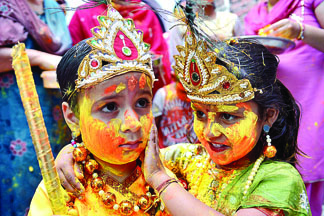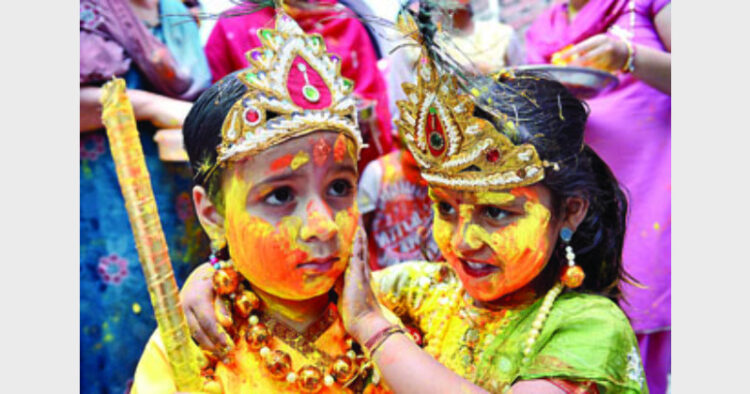 Holi is an ancient festival of Bharat and was originally known as”Holika”.The festival finds a detailed description in early religious works such asJaimini”s Purvamimamsa-Sutras and Kathaka-Grhya-Sutras. Besides having a detailed description in the Vedas and Puranas such asNarad Purana and Bhavishya Purana, the festival of Holi finds a mention in Jaimini Mimamsa. A stone incription belonging to 300 BC found at Ramgarh in the province of Vindhya has mention of Holikotsav on it. King Harsha, too has mentioned about Holikotsav in his work Ratnavali that was written during the 7th century.
Holi is an ancient festival of Bharat and was originally known as”Holika”.The festival finds a detailed description in early religious works such asJaimini”s Purvamimamsa-Sutras and Kathaka-Grhya-Sutras. Besides having a detailed description in the Vedas and Puranas such asNarad Purana and Bhavishya Purana, the festival of Holi finds a mention in Jaimini Mimamsa. A stone incription belonging to 300 BC found at Ramgarh in the province of Vindhya has mention of Holikotsav on it. King Harsha, too has mentioned about Holikotsav in his work Ratnavali that was written during the 7th century.
The famous Muslim tourist Ulbaruni too has mentioned about Holikotsav in his historical memories.
The festival also finds a reference in the sculptures on walls of old temples. A 16th century panel sculpted in a temple at Hampi, capital of Vijayanagar, shows a joyous scene of Holi. The painting depicts a Prince and his Princess standing amidst maids waiting with syringes or pichkaris to drench the Royal couple in coloured water. Historians also believe that Holi was celebrated by all Aryans but more so in the Eastern part of Bharat.
Story behind this colourful festival:
There was once a demon king by the name of Hiranyakashyap who won over the kingdom of earth. He was so egoistic that he commanded everybody in his kingdom to worship only him. But to his great disappointment, his son, Prahlad became an ardent devotee of Lord Naarayana and refused to worship his father.
Hiranyakashyap tried several ways to kill his son Prahlad but Lord Vishnu saved him every time. Finally, he asked his sister, Holika to enter a blazing fire with Prahlad in her lap. For, Hiranyakashyap knew that Holika had a boon, whereby, she could enter the fire unscathed.
Treacherously, Holika coaxed young Prahlad to sit in her lap and she herself took her seat in a blazing fire. The legend has it that Holika had to pay the price of her sinister desire by her life. Holika was not aware that the boon worked only when she entered the fire alone.
Prahlad, who kept chanting the name of Lord Narayana all this while, came out unharmed, as the lord blessed him for his extreme devotion.
Thus, Holi derives its name from Holika. And, is celebrated as a festival of victory of good over evil.
In several states of India, specially in the north, effigies of Holika are burnt in the huge bonfires that are lit on the eve of Holi. There is even a practice of hurling cow dungs into the fire and shouting obscenities at it as if they are shouting at Holika. Then every one shouts Holi-hai! Holi-hai!.
Further, people take a little fire from the bonfire to their homes. It is believed that by following this custom their homes will be rendered pure and their bodies will be free from disease.
Calculating the day of Holi:
According to this Purnimanta reckoning, Phalguna Purnima is the last day of the year and the new year heralding the Vasanta-ritu (with spring starting from next day). Thus the full moon festival of Holika gradually becomes a festival of merrymaking, announcing the commencement of the spring season. This perhaps explains the other names of this festival -Vasanta-Mahotsava and Kama-Mahotsava.
The colourful festival of Holi is celebrated by different names in this vast and culturally diverse country:
Lord Krishna is also associated with playing Holi with colours as the Lord started the tradition of playing Holi by applying colour on his beloved Radha and other gopis. Gradually, the play gained popularity with the people and became a tradition.
The tradition of playing colours is particularly rampant in north India. There can be no comparison to the Holi ofMathuraandVrindavan.
People take extreme delight in spraying coloured water on each other with pichkaris or pouring buckets and buckets of it. Singing Bollywood Holi numbers and dancing on the beat of dholak is also a part of the tradition. Amidst all this activity people relishgujiya, mathri, malpuasand other traditional Holi delicacies with great joy.
In south India, however, people follow the tradition of worshiping Kaamadeva, the love God of Indian mythology. People have faith in the legend which speaks about the great sacrifice of Kaamadeva when he shot his love arrow on Lord Shiva to break his meditation and evoke his interest in worldly affairs.
Nowhere it is celebrated with so much charm and enthusiasm as in Mathura, Vrindavan, Barsana and Nandgaon – the places associated with the birth and childhood of Lord Krishna. At Barsana Holi assumes the name ofLathmaar Holi. Here, women of Barsana give a tough time to men of Nandgaon as they come to play Holi with them. Women drag the unlucky captives, beat them, dress them in a female attire – yet all is in the spirit of Holi. This revengeful tradition is called theDulandi Holi.
The most enjoyable tradition of Holi, of course, apart from the play of colours is the tradition ofbreaking the pot.It is celebrated with much fan fair in the states of Maharashtra and Gujarat. Here a pot of buttermilk is hung high on the streets. Men form a huge human pyramid and one on the top breaks the pot with his head. All this while women keep singing Holi folk songs and throwing water at them. The tradition has its roots in the mischievous nature of Lord Krishna who was so fond of buttermilk that he used to steal it from every accessible house in the village.
In some parts of India, specially in Bengal and Orissa, Holi Purnima is also celebrated as the birthday ofShri Chaitanya Mahaprabhu (A.D. 1486-1533).
Holi is celebrated in the most dignified manner in the State of Bengal. At Vishwa Bharti University, founded by Rabindranath Tagore founded the tradition of celebrating Holi as”Basant Utsav”or”Spring Festival”. Students decorate the campus with intricate rangolis and carry out prabhat pheris in the morning. In other parts of Bengal, Holi is celebrated as Dol Yatra where the idols of Radha and Krishna are placed on a decorated palanquin and taken out in a procession.
For Sikhs, Holi calls for the display of their physical strength and military prowess as they gather at Anandpur Sahib a day after Holi to celebrateHola Mohalla. In the north-east, Manipuris celebrate the festival in a colourful manner for six continuous days. The highlight of the festival here is a special Manipuri dance, called”Thabal Chongba”.
Aniket Raja (With inputs from internet)













Comments